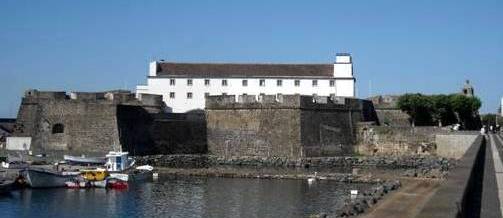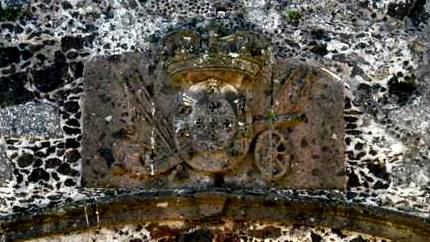
O Forte de S. Brás é o
modelo mais importante da arquitectura militar do séc. XVI
existente em S. Miguel. Foi a primeira fortificação inteiramente
construída em Portugal no estilo abaluartado renascentista
italiano.
Pensa-se que o forte deve
o seu nome a uma ermida em honra de S. Brás, que existia no lugar
onde este foi construído. Depois da sua construção, uma nova ermida
foi construída dentro do forte em honra a Sta Bárbara, padroeira da
artilharia.
O forte foi construído
devido à necessidade de protecção do porto original de Ponta
Delgada. Corsários e piratas eram atraídos pelos navios que
aportavam em Ponta Delgada, vindos da Índia e do Brasil e
transportando as maiores riquezas daquelas origens.
O rei D. João III ordenou
a sua construção começando este a ser construído em 1560/1567,
sobre a alçada do engenheiro Isidoro de Almeida e mais tarde,
continuado por Tomazio Benedetto, tendo sido considerado
operacional em 1580.
Em 1575, a torre onde se
encontravam os sinos, no convento de S. Francisco foi mandada
destruir, porque dominava o forte ainda em construção. Contudo,
esta medida foi ineficaz. Em 1789 o terraço do convento dominava o
parapeito e a parada do forte.
O seu primeiro
Alcaide-mor foi o conde de Vila-Franca, Manuel da Câmara, e o seu
primeiro Sargento-Mor foi João Fernandes de Grado.
Desde 1585, o forte sofreu diversas
alterações que modificaram a sua arquitectura primitiva.
Actualmente é utilizado como Comando da Zona Militar dos Açores e
Museu Militar dos Açores.
* *
*
The São Brás fortress is the most important example of 16th
century military architecture in São Miguel. It was the first
fortification in Portugal completely constructed using the Italian
renaissance bastion style.
It is thought that the fort owes its name to a chapel in
honour of São Brás (Saint Blais) that existed on the site of the
fort. A new chapel was erected within the new fort in honour of
Santa Barbara the patron saint of artillery.
The fort was constructed to protect Ponta Delgada´s
original port. Corsairs and pirates were attracted to the ships and
their rich cargoes while they replenished their stores in Ponta
Delgada on their return from Brazil and India.
King Dom João III ordered construction of the fort which
was started between 1560 and 1567 under the watch of Engineer
Isidoro de Almeida and later Tomazio Benedetto. The fort was
considered operational in 1580.
In 1575 the bell tour of the nearby Convent of São
Francisco was demolished as it was deerned to dominate the new
fort. The result was negated as the convent´s terrace still
dominated the forts walls when construction was
finished.
The first Alcaide-mor was the count of Vila Franca, Manuel
da Camara, and the first Major General was João Fernando do
Grado.
The fort was undergone a number of alternation since 1585
that have modified its primitive architecture and it currently
houses the Military Command for the Azores and the Military Museum
of the Azores.

O Museu Militar
Ao visitarmos o Forte não
podemos deixar admirar o Museu Militar dos Açores (M.M.A.), que
abriu actividade no ano 2006 e tem como função principal a recolha,
preservação e exposição de todos os artefactos humanos relacionados
com a história militar dos Açores.
Durante a visita podemos
admirar, numa primeira fase, a exposição de Fardamento e, de
seguida, a exibição de Artilharia, na Bateria D. Maria
II.
Depois, encontramos o
túnel da II Guerra Mundial, onde se pode admirar uma exposição de
metralhadoras pesadas, uma sala de exposição permanente intitulada
de “200 anos de armas brancas e de fogo”, um conjunto
de seis paióis do séc. XIX, uma exposição de Engenharia e
Comunicações militares, entre muitas outras coisas.
Durante a visita é possível subir às
muralhas do forte, que circundam todo o edifício.
* *
*
Military
Museum
When visiting the fort, we must stop to see the azorean
military museum which opened in 2006 and hás as a primary task,
collecting, preserving and exhibiting all human artefacts related
to the Azorean military history.
During the visit we may admire the uniform exhibit followed
by the artillery in the D. Maria wing.
Afterwards, we will find the II world war tunnel, where the
heavy artillery is, namely machine guns, a permanent exhibit room
named “200 years of blades and
fire weapons”, a set of galleries of the 19th century, a
military communication gear exhibit, among several other
things.
During the visit
it is allowed to climb the fort’s walls, which circle the
entire construction.

Horário/schedulde:
Terça a Sexta-feira/Tuesday to Friday: 10H -» 18H
Sábado/Saturday: 14H -» 18H
Domingo,
Segunda e feriados/Sunday, Monday and Holiday:
fechado/closed
Preços/price: Crianças até aos 12
anos/children till 12 : Gratuito/free
Adultos/adults: 1
€
Grupos acima das 10
pessoas/groups above 10 people: 50 cents pp
A Cache encontra-se fora
do forte, estando assim acessível a qualquer hora.
The cache is
located outside the fort, being therefore accessible at all
times.